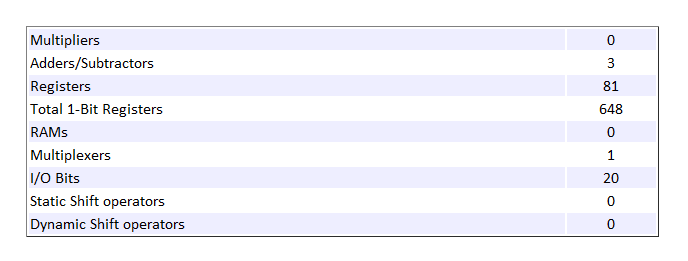RAM Mapping with the MATLAB Function Block
This example shows how to map persistent arrays to RAM by using the MapPersistentVarsToRAM block-level parameter. The RAM size must be greater than or equal to the RAMMappingThreshold. The resource report shows the difference in area improvements resulting from RAM mapping.
Line Buffer Model
Open the model hdlcoder_ram_mapping_matlab_function.
open_system('hdlcoder_ram_mapping_matlab_function') set_param('hdlcoder_ram_mapping_matlab_function', 'SimulationCommand', 'Update')

The DUT Subsystem in the model drives a Line Buffer MATLAB Function block.
open_system('hdlcoder_ram_mapping_matlab_function/HDL_DUT')

To see the MATLAB® code implementation of the line buffer, open the MATLAB Function block.
open_system('hdlcoder_ram_mapping_matlab_function/HDL_DUT/Line Buffer')

Generate HDL Code
1. Enable generation of the resource utilization report. The report displays the number of adders, subtractors, multipliers, registers, and RAMs that the design consumes.
hdlset_param('hdlcoder_ram_mapping_matlab_function', 'resourcereport', 'on')
2. Generate HDL code for the HDL_DUT Subsystem.
makehdl('hdlcoder_ram_mapping_matlab_function/HDL_DUT')
HDL Coder™ displays the Code Generation Report. In the report, select the High-Level Resource Report section. The design consumes 81 registers and 648 1-bit registers. By default, the MapPersistentVarsToRAM property is disabled and the code generator does not infer or consume RAM resources.

Enable RAM Mapping and Generate HDL Code
1. Enable the MapPersistentVarsToRAM HDL parameter on the MATLAB Function block.
ml_subsys = 'hdlcoder_ram_mapping_matlab_function/HDL_DUT/Line Buffer'; hdlset_param(ml_subsys, 'MapPersistentVarsToRAM', 'on')
2. Generate HDL code for the HDL_DUT Subsystem.
makehdl('hdlcoder_ram_mapping_matlab_function/HDL_DUT')
In the Code Generation Report, select the High-Level Resource Report section. The design consumes one register, eight 1-bit registers, and one RAM. The number of RAMs inferred depends on the RAMMappingThreshold that you specify. See RAM mapping threshold.

RAM Mapping with MATLAB Datapath Architecture
The MATLAB Datapath architecture treats the MATLAB Function block like a regular Subsystem. The architecture converts the MATLAB code that you wrote to a dataflow representation in Simulink®. HDL Coder can then more widely use optimizations across the MATLAB Function block with other Simulink blocks in your model.
1. Enable the MATLAB Datapath HDL architecture and then set the MapPersistentVarsToRAM parameter on the MATLAB Function block.
hdlset_param(ml_subsys, 'Architecture', 'MATLAB Datapath') hdlset_param(ml_subsys, 'MapPersistentVarsToRAM', 'on')
2. Generate HDL code for the HDL_DUT Subsystem.
makehdl('hdlcoder_ram_mapping_matlab_function/HDL_DUT')
The High-Level Resource Report indicates that the design consumes the same number of resources as the design that used the default architecture of the MATLAB Function block. To see how MATLAB Datapath architecture modifies the MATLAB code to a Simulink dataflow representation, open the generated model gm_hdlcoder_ram_mapping_matlab_function and navigate to the HDL_DUT Subsystem. There is a Line Buffer Subsystem in place of the MATLAB Function block. Inside the Subsystem block is the dataflow representation that displays a RAM block inferred.

To learn about design patterns that enable efficient RAM mapping of persistent arrays in MATLAB Function blocks, see the eml_hdl_design_patterns/RAMs library.